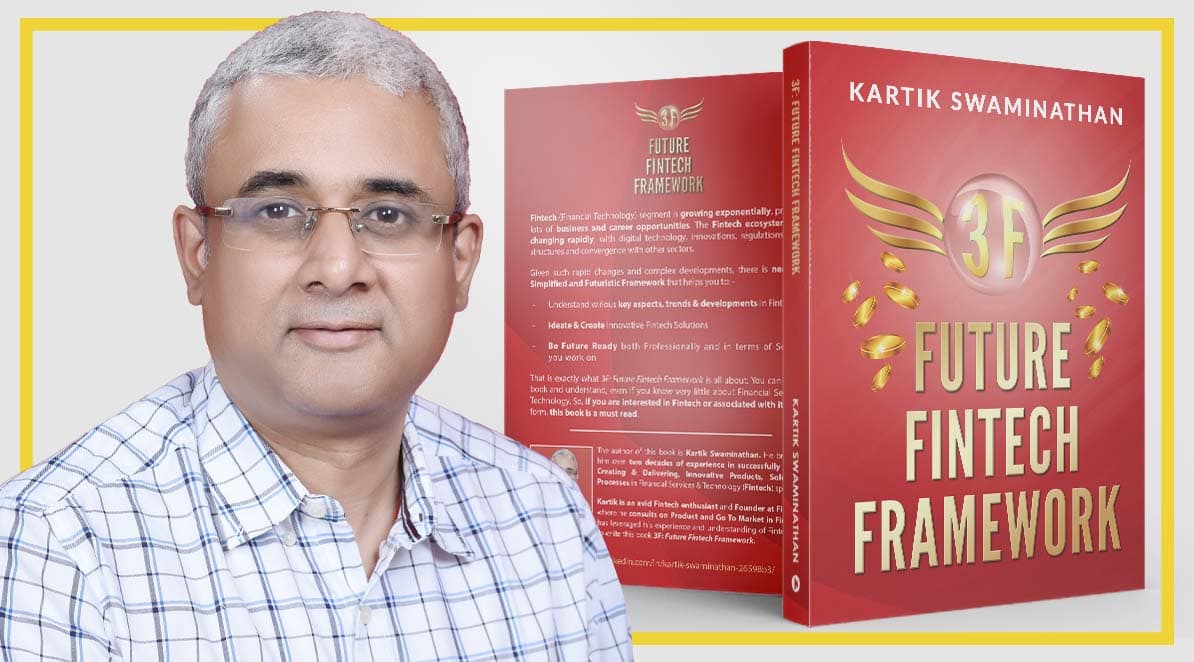“A Vision to Simplify Understanding, Foster Innovation and Accelerate Growth in Fintech.”
In January one of the stalwarts of the Fintech Community, Kartik Swaminathan, Founder of Fintastech.in, wrote a book called 3F – Future Fintech Framework.
With record amounts of interest in Fintech, both due to the pandemic and digitalisation, as well as due to the impact StartUps like Klarna, Revolut and Stripe have had on traditional banking. Kartik decided that there was a need for a Simplified and Futuristic Framework to help others understand the amount of disruption taking place in the Fintech segment globally.
3F: Future Fintech Framework is a book that simplifies understanding across all key trends and themes in Fintech, and proposes futuristic framework for growth and innovation in Fintech. The book is available at https://t.co/FUARFmInN4 (also available on Amazon, Kindle globally)
— Kartik Swaminathan (@iamkartik) March 18, 2021
Kartik spoke with #DisruptionBanking about his recent book and shared some background about his project with us:
“Fintech as the word suggests is the application of Technology to the world of Financial Services, Banking, Investments, Insurance, etc. Over the years, the scope of Fintech has expanded to encompass many aspects like digital, social media, internet, etc., and it has grown in application and size.
“Fintech solutions are also increasingly becoming part of our lives, and impacting our daily activities. For instance making and receiving payments for various purposes like bill payments, purchasing, investing, securing, borrowing, donating, etc.
“On the one hand, we have seen the emergence of various solutions like digital wallets, robo advisors, neo banks, payment apps, etc.. On the other hand, Fintech-driven solutions are being embedded and powering growth in ecommerce. These Fintech solutions have not only added convenience in availing these products and services, but also made the experience more rewarding, not to mention the choices and benefits provided.
“All this has happened because of various developments in financial technology, the StartUp ecosystem and government regulations. However (and it is a big ‘however’), this evolution is not without its pitfalls and challenges. There is clearly a need to clarify how the ecosystem can be given a more ‘future-ready’ framework.”
3F – Future Fintech Framework
When he published his recent book, Kartik Swaminathan joined a growing group of Fintech Influencers who have published books in the past. Influencers like Chris Skinner who published Digital Human, Digital Bank or Doing Digital. Like Brett King who published Bank 4.0, or like Susanne Chishti who was one of the editors of The Paytech Book.
Has 3F lived up to the acclaim? Kartik explained more about the book:
“So, enter 3F – Future Fintech Framework. A book that tries to bring in a very simplified understanding of various aspects driving and impacting Fintech. 3F framework is technology and product agnostic, and can thereby be applied to most product and solution related use cases in Fintech. In fact, 3F can also be useful for other digital sectors like ecommerce, online education, travel, health tech etc.
“Put simply, just like applying the 4P’s or the AIDA Model/Framework of marketing helps us to effectively structure and market products, or how the Agile framework helps us with a structure to manage projects, similarly, 3F – Future Fintech Framework consists of components which enable structuring and creating futuristic solutions in the Digital/Fintech space.
Kartik has also attended several online digital banking events where he has show-cased his book:
Had a rapidfire discussion on Fintech and my recent book, courtesy Babu Nair and his team at Banking Frontiers – https://t.co/22C2awLLqa
— Kartik Swaminathan (@iamkartik) May 12, 2021
Read more on 3F: Future Fintech Framework at – https://t.co/kEzXlTOayk#fintech #innovation #Digital #digitalbanking #blockchain
The 3 Sections of the Future Fintech Framework
Section 1 (Key Fintech Themes)
Highlights emerging trends and themes that are driving innovation in Fintech. Including Onboarding, Multilingual, Digital Footprint / Identity, Chatbots, 5G, Blockchain, Analytics, Aggregation etc. A total of 64 themes and trends encompassing all that is happening in the Fintech & digital space. Besides helping develop an overall picture of the Fintech & Digital ecosystem; the themes are triggers to ideate & innovate.
Section 2 (3F: Future Fintech Framework)
Consisting of 3 Frameworks for Innovation & Growth viz.
Fintech Digital Life Cycle (FDLC) – FDLC helps in creating engaging user journeys / experience across 7 stages and 39 sub stages. The basic premise is all features / use cases will eventually manifest in the form of a user journey and the FDLC will help you design these engaging journeys. FDLC is also Technology and product Agnostic. All Fintech and Digital products or solutions begin with client acquisition & end with ‘Offboarding’. The FDLC helps understand how to ensure that there is a “call to action” principle while defining each feature.
Fintech Logical Architecture (FLARE) – In the digital age you need a common set of logical blocks under which you can define various functionalities that will enable a true digital solution. FLARE is an architecture with 14 easy to understand functional / logical components, providing clarity for better collaboration and documentation amongst stakeholders.
Fintech API Marketplace (FAM) – The book foresees the evolution of FAM’s, a futuristic and realistic Fintech API marketplace, which will power the fintech & digital ecosystems of the future. They will also drive partnerships and make Go To Market very fast and smooth. The book also provides an example to this effect which helps you visualise what FAM’s will do.
Swaminathan summarizes these 3 main frameworks in Section 2:
“They will help you in organising your thoughts and ideas into more engaging user journeys, logical blocks for effective documentation & collaboration. Whilst keeping one eye on a futuristic (but realistic) API Marketplace.”
Section 3 (Other Key Fintech aspects)
This last section provides insights on some key aspects that one needs to be aware of.
Fintech players ecosystem – To understand the Fintech landscape, you need to fully understand the various types of players and how these players are evolving. Be it regulatory bodies, quasi regulatory / industry bodies, Tech companies, BFSI Players, new players etc. they all have a role to play in supporting each other. It is not just the player categories, the book captures some generic bundling and unbundling trends, that provide insights on how different types of players are likely to evolve.
Changing revenue, pricing and charges mix – While we understand the players, it is also important to understand the various aspects that commercially drive them, and how they are changing. So, be it a move from Capex to Opex, different types of charges and their respective drivers, the book provides insights on all these including how the mix has historically evolved.
Regulations – Be it the licencing of a new segment, new rules or policies; regulations play a big role in Fintech. There have been developments in privacy norms and there are other challenges and limitations like cybersecurity, fraud, consumer protection, mis-selling and a host of other aspects. The book discusses these, and also provides some solutions & suggestions.
Emerging roles & careers in Fintech – Have you come across Product Managers, Business Analysts & Project Managers in banking structures in the past? Today, almost all banks have employees in these traditional ‘Tech’ roles. The book provides insights on new roles that will emerge, and how they will empower the future fintech / digital ecosystem. Ultimately humans will still be the main element needed in driving and running a fintech / digital businesses.
Kartik summarizes the main Sections:
“The digital world encompasses a shift from Products to Customers and from Processes to User Journeys and that is what 3F: Future Fintech Framework both aptly captures and enables. There are some nice business quotes that resonate well with all that the book talks about, and these make for an interesting wrap up to the book.
“For example:
“You cannot Sell anything, if you cannot tell anything” – Beth Comstock, Vice Chair of General Electric
“The most powerful person in the world is the story teller. The storyteller sets the vision, values 7 agenda of an entire generations that is to come” – Steve Jobs
“The book is written for all levels of Fintech professional. Students, especially graduates, looking for a career in Fintech will find the book particularly useful.”
3F: Future Fintech Framework is available globally as physical and eBook versions on Amazon, Kindle and other options. Follow the link to buy in UK – https://www.amazon.co.uk/dp/1637147236
About the Author
The author of 3F: Future Fintech Framework is Kartik Swaminathan. Hebrings with him over 20 yrs of experience in successfully Ideating, Creating & Delivering, Innovative Products, Solutions & Processes in Fintech space. He has worked on range of solutions across Investment & Wealth Management, Global Payments, Lending, Trading, Financial Planning, Asset Management, Neo Banking, Financial Inclusion, compliance, fraud management & eGovernance.
Kartik is an avid Fintech enthusiast and Founder at Fintastech.in, where he consults on Product and Go To Market in Fintech. He has leveraged his experience and understanding of Fintech Space to write this book.
Author: Andy Samu
#OpenBanking #Fintech #FintechDigitalLifecycle #FLARE #FintechAPIMarketplace #3F #BookReview #FutureFintechFramework














